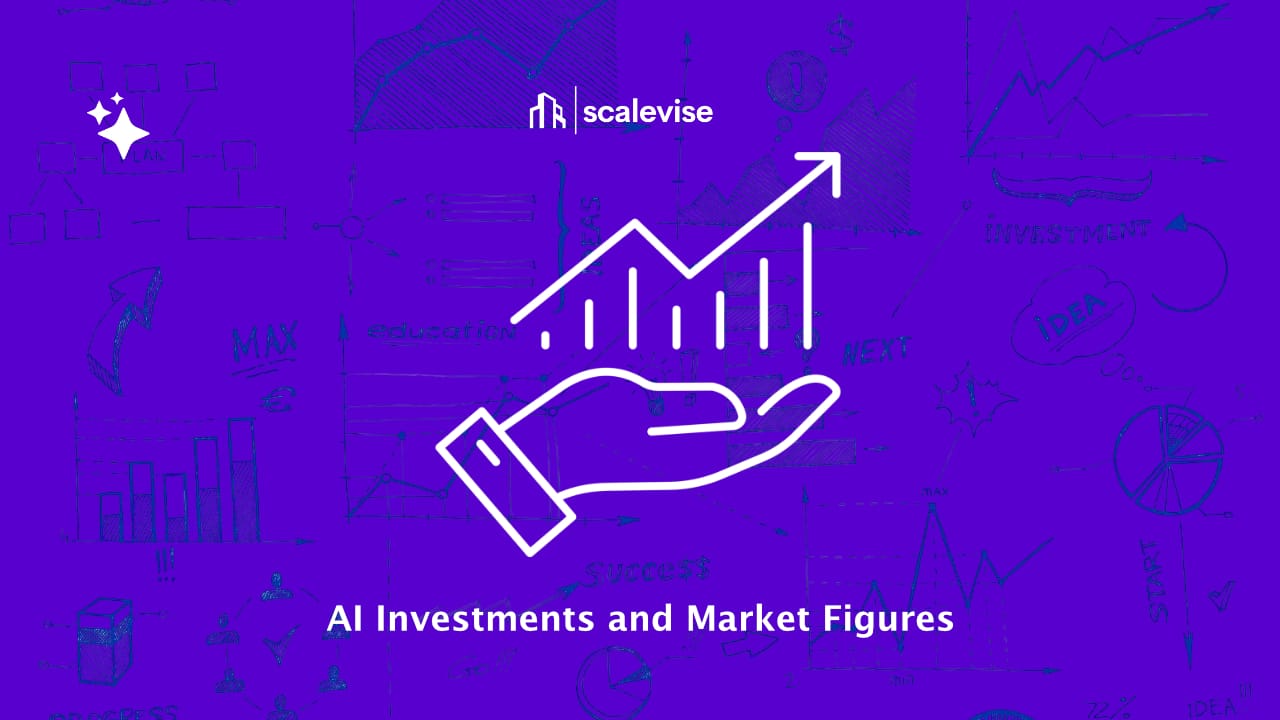AI Investments and Market Figures: Growth, Strategy, and Impact

The Global AI Market: Closing in on $400 Billion
Artificial intelligence has moved far beyond its experimental phase. According to Exploding Topics, the global AI market currently sits at nearly $400 billion. This is not a niche technology anymore — it is one of the primary growth engines of the global economy.
What makes this figure striking is not only its size but also its growth trajectory. Analysts project a compound annual growth rate (CAGR) of roughly 35–38%, which places AI among the fastest-growing industries worldwide. For comparison, the global IT services market typically grows around 5–7% annually. AI is expanding at a rate five times higher.
By 2030, this market could exceed $1.8 trillion (Grand View Research), creating entirely new business models and altering the structure of existing industries.
Strategic Priority: 83% of Companies Invest in AI
The growth numbers only tell part of the story. Another critical insight is that 83% of international businesses list AI as a top strategic priority (Exploding Topics). This illustrates how organizations now see AI not as optional, but as essential for staying competitive.
Enterprises are directing budgets toward AI in three dominant areas:
- Automation: Streamlining workflows and reducing manual tasks.
- Customer experience: Delivering personalized services, faster responses, and predictive recommendations.
- Decision-making: Leveraging data-driven forecasting and advanced analytics.
This level of adoption demonstrates a fundamental shift: AI has become a core element of corporate strategy, not just a technology experiment in innovation labs.
Workforce Dynamics: 97 Million AI Jobs
The rapid adoption of AI naturally impacts global employment. By the end of this year, an estimated 97 million people will be working in AI-related roles worldwide.
This workforce includes not just software engineers and data scientists, but also ethicists, compliance experts, and domain specialists who ensure AI is applied responsibly. While certain roles are being automated, AI simultaneously generates new categories of employment.
However, the workforce shift is not without tension. Entry-level positions are at higher risk of automation, while specialized skills become more valuable. Companies that invest in retraining and upskilling their employees will be better positioned to thrive.
Economic Impact: $15 Trillion by 2030
Perhaps the most staggering figure is the economic potential. Studies predict that AI will contribute more than $15 trillion in additional revenue to the global economy by 2030.
Breaking this down:
- North America could see GDP gains of 14–15%.
- China could experience up to 26% GDP growth directly attributed to AI (Brandwell.ai).
- Globally, AI’s productivity enhancements are expected to outpace any previous technological revolution.
Morgan Stanley estimates that AI alone could create $13–16 trillion in added value for the S&P 500 through productivity gains (Business Insider).
These figures highlight AI’s transformative role not just as a tool, but as a macroeconomic driver.
Risks and Challenges That Cannot Be Ignored
While the opportunities are immense, the risks are equally pressing. A balanced view requires acknowledging challenges such as:
Job Displacement
Goldman Sachs projects that as many as 300 million jobs worldwide could be impacted by automation. Morgan Stanley warns that up to 90% of existing roles will undergo transformation or face partial automation. This is a seismic shift in the labor market that governments and enterprises cannot ignore.
Ethical and Legal Concerns
AI introduces challenges around bias, transparency, and intellectual property. Misuse or poorly governed AI systems could erode trust and trigger regulatory pushback.
Energy and Infrastructure
The compute requirements for large-scale AI models consume vast amounts of energy. As adoption grows, sustainability becomes a critical issue.
Hype Versus Reality
There is a risk of overinvestment without tangible ROI. Businesses must carefully align AI projects with measurable outcomes rather than chasing headlines.
Strategic Recommendations for Business Leaders
To navigate this landscape, organizations should adopt a disciplined approach:
- Balance automation with human expertise: Don’t automate blindly; design workflows where humans and AI complement each other.
- Invest in governance: Build compliance, security, and ethics into your AI roadmap.
- Upskill continuously: Equip employees with the skills needed to work alongside AI systems.
- Measure impact: Define success metrics early and track ROI across projects.
- Think long-term: Beyond cost reduction, focus on how AI can create new revenue streams.
Conclusion: From $400 Billion to $15 Trillion
AI has already become a $400 billion market, and its trajectory suggests it will reshape the global economy, workforce, and competitive landscape over the next decade. With forecasts of $15 trillion in added value by 2030, the question is no longer whether to adopt AI, but how to do so effectively and responsibly.
Companies that invest strategically today will be positioned to capture the outsized benefits tomorrow. Those that hesitate risk being left behind in industries where intelligence and automation set the pace.
